The hydrogeological situation on 1 June 2023
Early spring precipitation slowed the emptying of aquifers in the areas that received the most. In May, there was not enough precipitation to generate recharge episodes and improve the state of the aquifers. Most levels are falling.
The situation remains unsatisfactory across much of the country: Sixty-six percent of aquifer levels were still below monthly norms in May (68% in April 2023) with low to very low levels in many areas.
In June and for the next quarter, aquifer levels are expected to continue to fall. Recharge episodes are expected to be occasional and not particularly intense, unless there are exceptional rainfall episodes. Any changes to the state of the aquifers will depend on their reactivity, cumulative local rainfall, evapotranspiration and the demand for water. The situation will need to be closely monitored in aquifers which currently have low to very low water levels, as well as in areas where abstraction demand is particularly high.
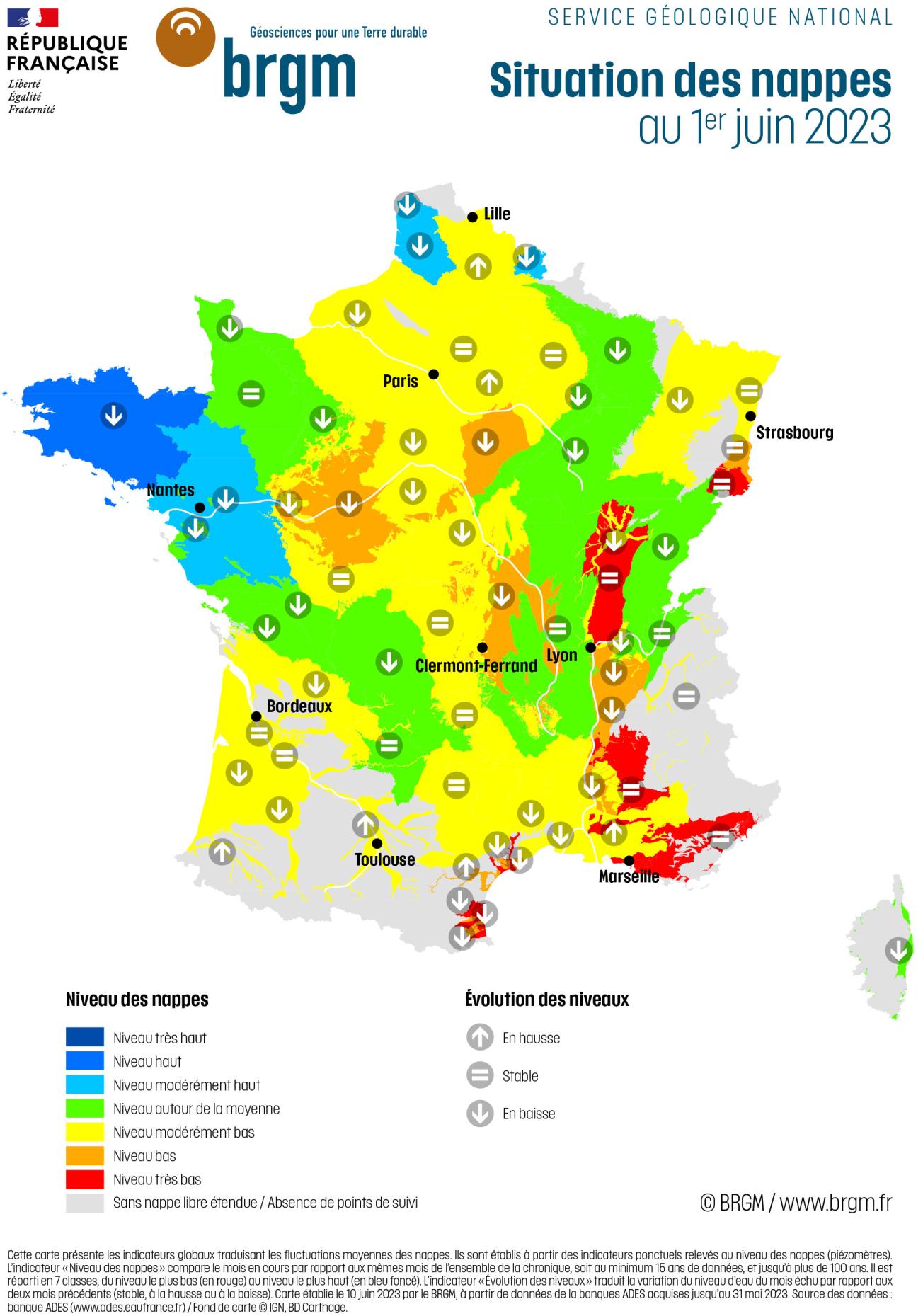
Map of groundwater levels in France on 1 June 2023.
© BRGM
Groundwater trends
The 2022-2023 recharge period was deficient over a large part of France. Early spring rainfall led to recharge episodes, thus pushing back the start of the depletion period in those areas with the highest rainfall. In May, rainfall infiltration was generally non-existent or insufficient to generate a recharge episode. Most aquifers are currently being depleted: Levels at 60% of the observation points have dropped (38% in April).
As regards the inertial water tables of the Paris Basin and the Artois Basin, depletion commenced in May. Effective rainfall can take up to 3 months to reach the aquifers. The rising or stable water levels, particularly in the north-east of this sector, are therefore the result of rainfall infiltration in early spring. The inertial water tables in the Rhône-Saône corridor are falling, with the emptying period being underway since March-April.
The levels of reactive aquifers are generally decreasing. Rainfall in May had an impact on the aquifers in the south and centre of France. Around the Mediterranean coastline and Corsica, the rain mainly moistened the soil and was taken up by the vegetation. It rarely managed to infiltrate deep down and had little impact on the aquifers. Levels in the Massif Central aquifers are stable. Rainfall in the Causses du Quercy and in Provence caused a peak in flooding in the Jurassic limestone aquifers. The trends for the alluvial aquifers of the Adour and Gave de Pau, the upstream Garonne and its tributaries and the Aude are upwards.
Situation in relation to May averages
In 2022, the low-water period was severe for most of the aquifers, with recharging levels remaining low during the autumn and winter of 2022-2023. At the end of the winter, the situation of the aquifers was therefore unsatisfactory. Rainfall in early spring improved the condition of the most reactive water tables in the northern two-thirds of the country.
During May, the situation of the aquifers changed little and remained unsatisfactory overall: Levels at 14% of the observation points were above monthly norms (17% in April). However, 66% of the levels remained moderately low to very low (68% in April) while 19% were very low (20% in April). The situation is similar to that of last year (69% of levels were below normal in May 2022) but with greater variation.
Over a large part of northern France, precipitation in March and April improved the state of the reactive basement aquifers and of the Jurassic and Cretaceous limestone aquifers. In May, despite the lack of recharge, levels remained generally satisfactory, ranging from comparable to normal-to-high, but several sectors (Lorraine, Berry, Brenne, Périgord, Millevaches) recorded moderately low levels. In the southern third of the country, reactive-aquifer levels, ranging from moderately low to very low, are not very favourable. The rainfall in May was far from adequate to make up for the deficits of recent months.
As far as the inertial aquifers are concerned, the situation remains generally stable compared with the previous month. The state of the inertial aquifers in the Paris Basin is not very favourable, with levels generally being moderately low to low. The situation may be problematic locally, with low to very low levels, particularly in the centre and west of the Paris Basin. Only the chalk aquifer of the Artois-Picardy coast benefited from a significantly excessive recharge and has a high level. Aquifer levels in the Rhône-Saône corridor are problematic, being low to very low. Historic lows have been recorded in several areas of the river-glacier, plioquaternary and Miocene molasse aquifers in the Dijon, Bresse, Dombes, East Lyon and Dauphiné regions.
Aquifers in good condition
The situation is good in several aquifers, with moderately high to high levels in comparison to those recorded in May in previous years:
- The aquifers of the Armorican Massif basement, from Brittany to the Vendée, benefited from excess rainfall in March and April, so levels are moderately high to high;
- The levels of the Cenomanian chalk marl aquifer on the Artois-Picardy coast are moderately high, following the excess recharge of 2022-2023;
- The Avesnois Carboniferous limestone and Boulonnais Jurassic limestone aquifers have moderately high levels, as a result of excess recharge in 2022-2023.
Aquifers in an unfavourable condition
Many aquifers are in an unfavourable condition with very low levels compared to May levels for previous years, owing to an extreme rainfall deficit in recent months:
- The levels of the inertial aquifers from the Dijon area to Bas-Dauphiné are low to very low, owing to the low intensity of several successive winter recharges;
- The coastal alluvial aquifers and karst limestone aquifers of Provence and the Côte d'Azur have very low or even historically low levels, due to a lack of rainfall in 2022 and 2023;
- The aquifers of the Roussillon multi-layer aquifer are in an unprecedented condition, with low levels in the deep Pliocene aquifer and very low levels in the near-surface aquifer. Some points in the near-surface aquifer have historically low levels, with a high risk of salt-water intrusion.
Comparison between 1 June 2022 and 1 June 2023
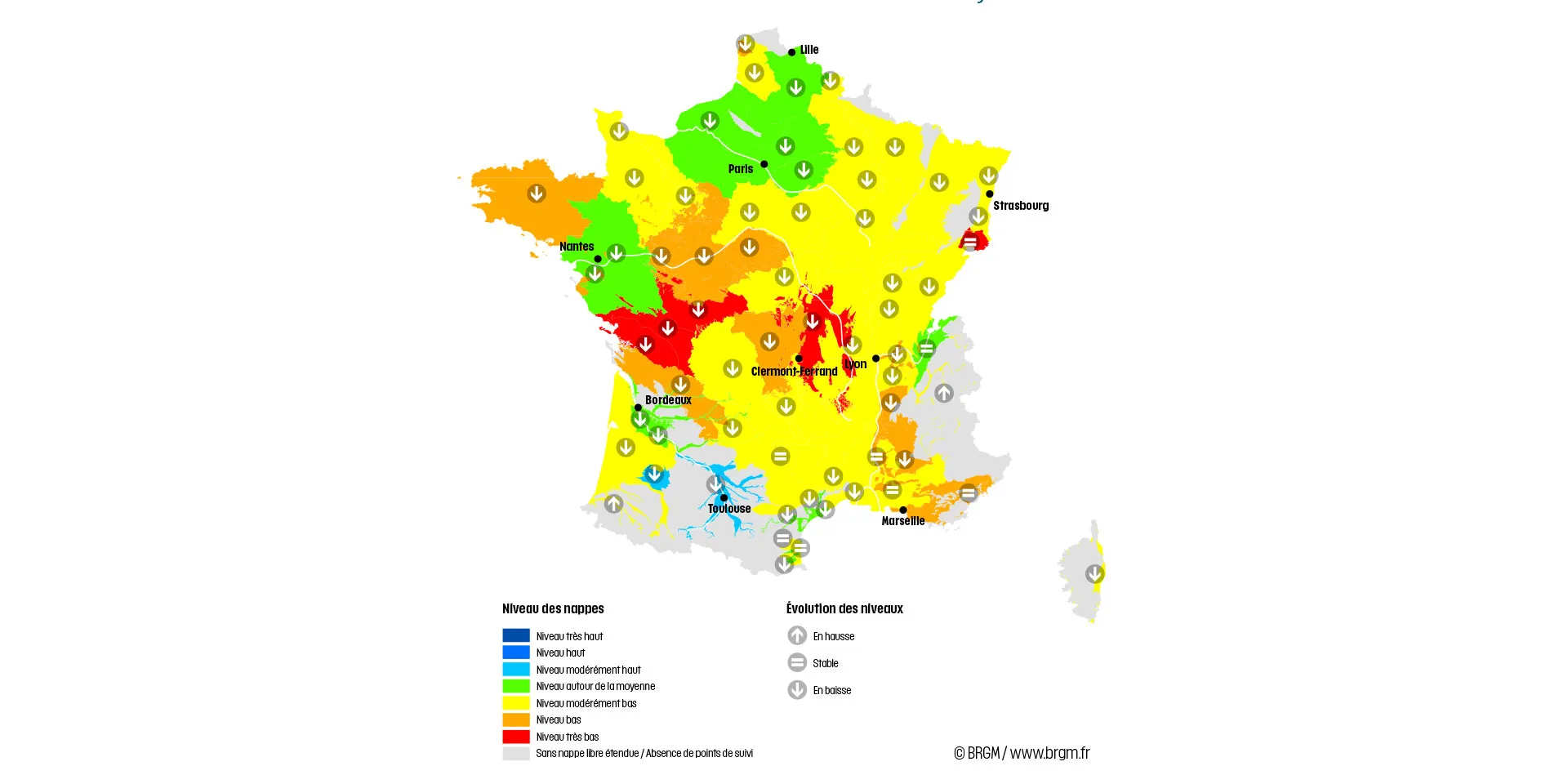
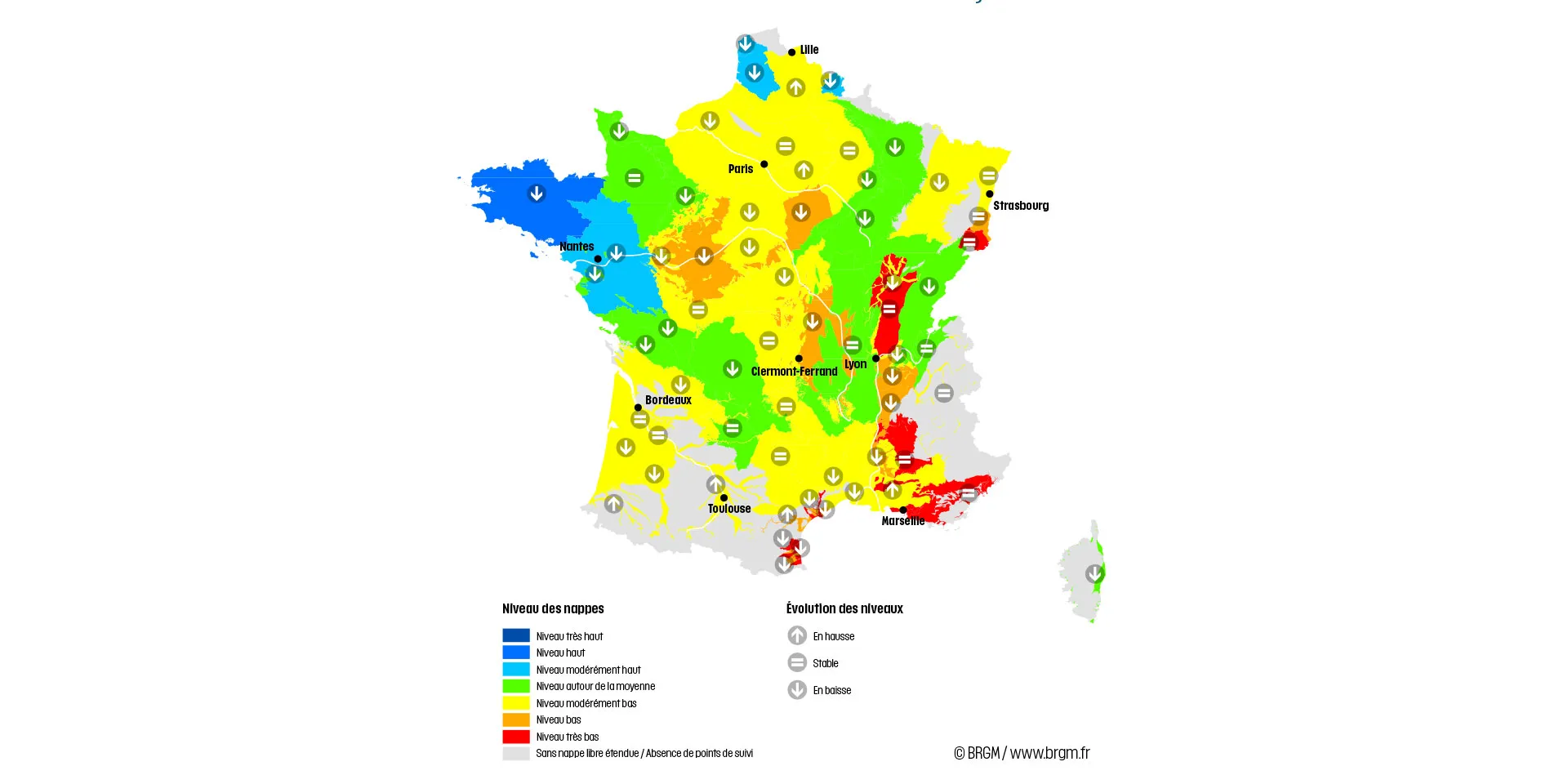
Map of France showing the state of the aquifers on 1 June 2022 (left) and 1 June 2023 (right).
© BRGM
Forecasts
Météo-France seasonal forecasts for June, July and August do not indicate any particular scenario for rainfall, but temperatures are expected to be higher than normal across France. High temperatures, the regrowth of vegetation and thus increased evapotranspiration usually limit the infiltration of rainfall into aquifers during spring and summer. High temperatures could contribute to an increase in water abstraction and the amount of water required by vegetation. Theoretically, depletion should therefore continue and the levels should remain on a downward trend for the next few weeks.
As regards the inertial aquifers of the Artois Basin, the Paris Basin and the Rhône-Saône corridor, it is unlikely that there will be recharge episodes during the summer, barring very exceptional rainfall events. So no improvement is likely before the autumn. The situation is expected to gradually deteriorate, more or less rapidly depending on the volumes of groundwater abstracted.
With regard to the reactive aquifers, rainfall infiltration at depth will be very limited over the next few months, and depletion is likely to continue. For levels to increase and for the condition of the aquifers to improve, significant rainfall would be needed, over soils that are already damp. Rainfall in early June could affect the aquifers in the south of France, as the near-surface upper boundaries of aquifers were moistened by rainfall at the end of May. Rain is unlikely to infiltrate deeply over the rest of the country as long as the soil remains dry and vegetation lacks water. The situation is likely to deteriorate rapidly for aquifers that do not benefit from small recharge events and for those that are most affected by abstraction.
The situation will need to be closely monitored in aquifers which currently have levels that are below the May monthly norms, as well as in areas where abstraction demand is particularly high.
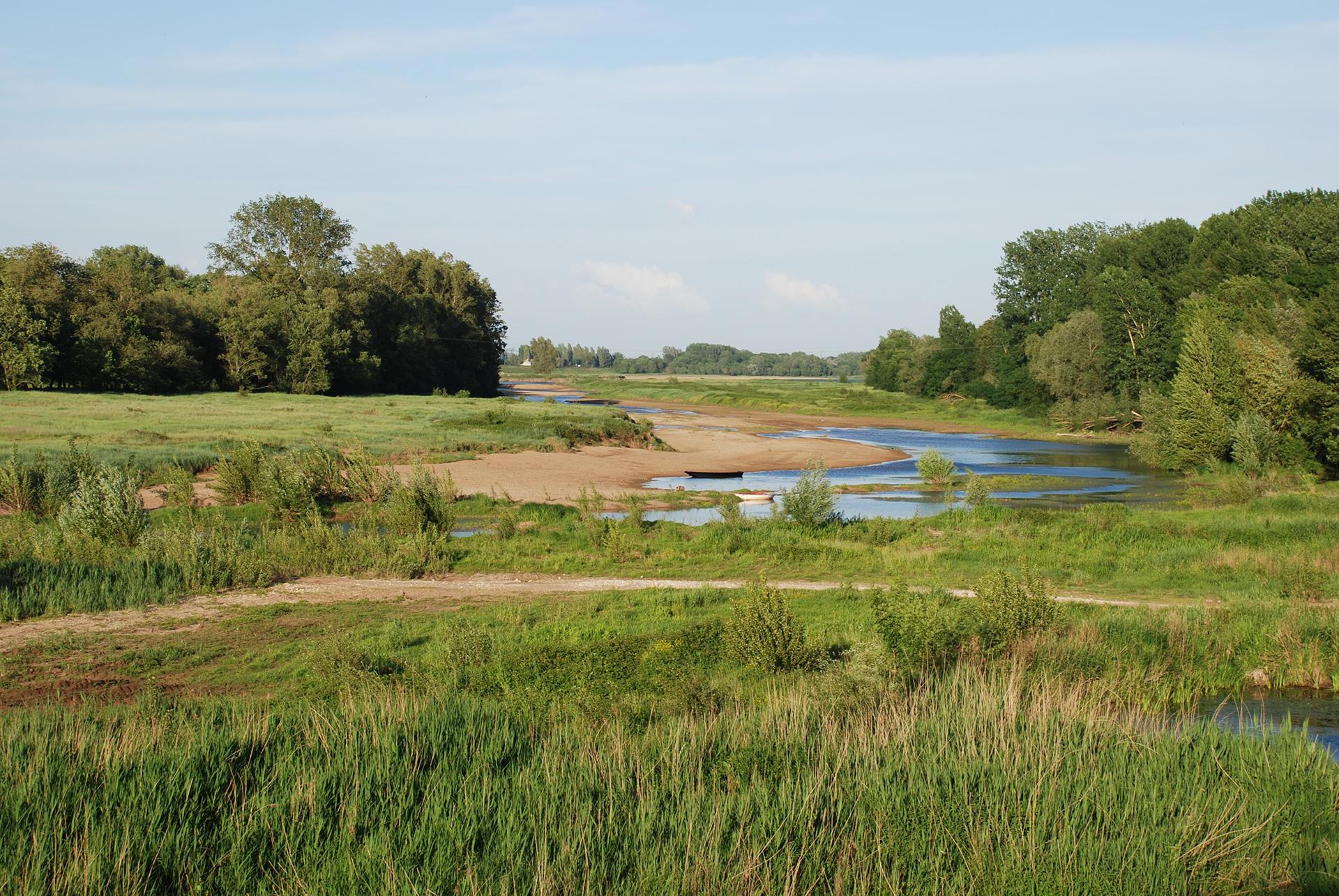
State of groundwater: monitoring by BRGM
Groundwater is a widely used resource: in metropolitan France, it accounts for nearly two-thirds of drinking water consumption and more than one-third of agricultural water consumption. It is also widely used in the industrial sector. Groundwater tables depend on cyclical recharges.
BRGM monitors groundwater levels and quality in mainland France. Discover the actions carried out by the French geological survey and the resources and databases available on groundwater in France.
Press contact


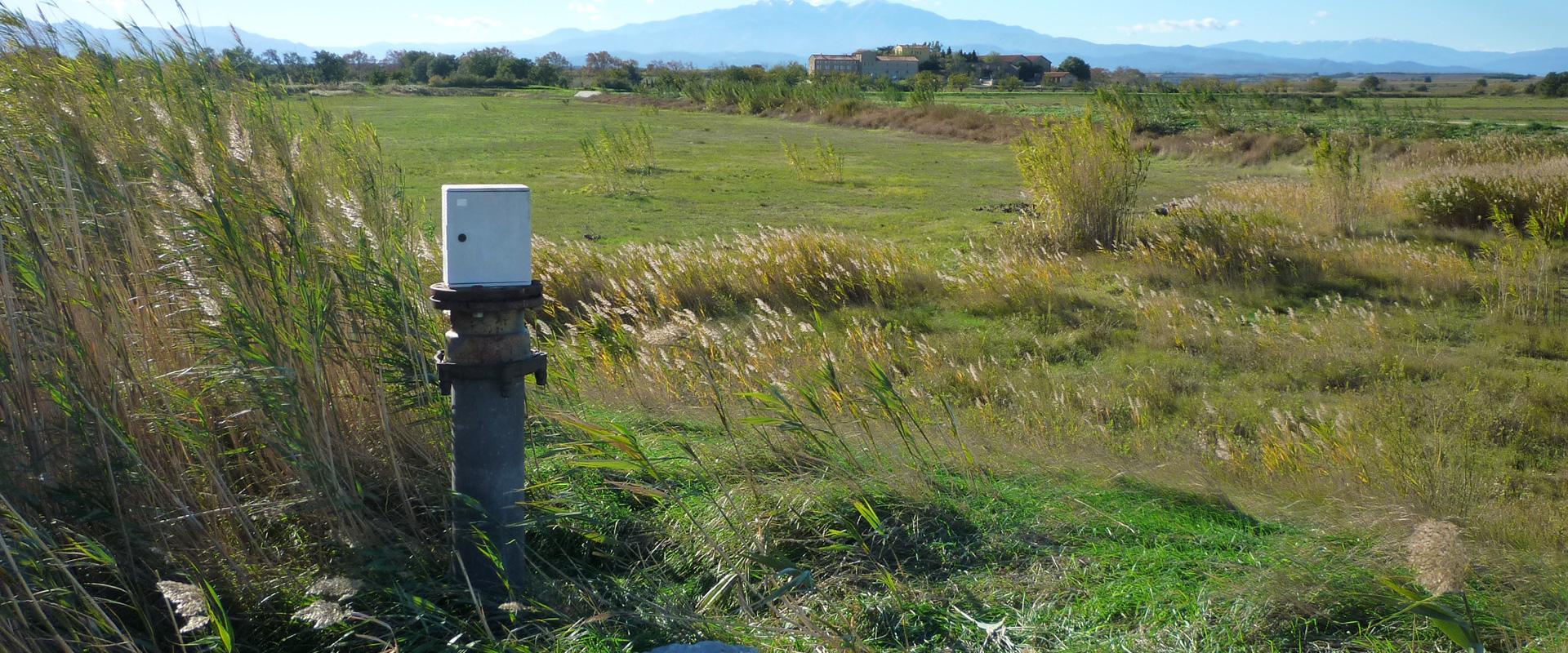
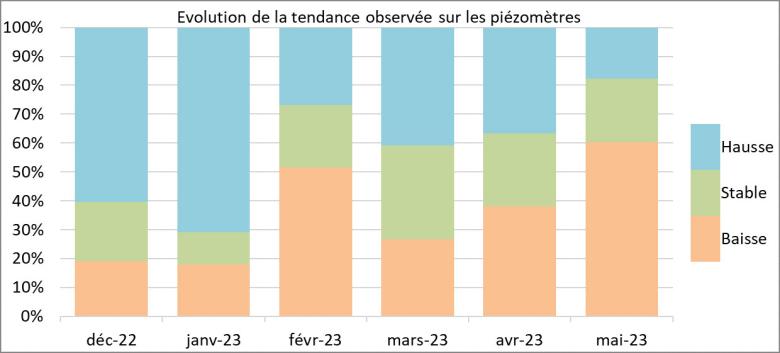
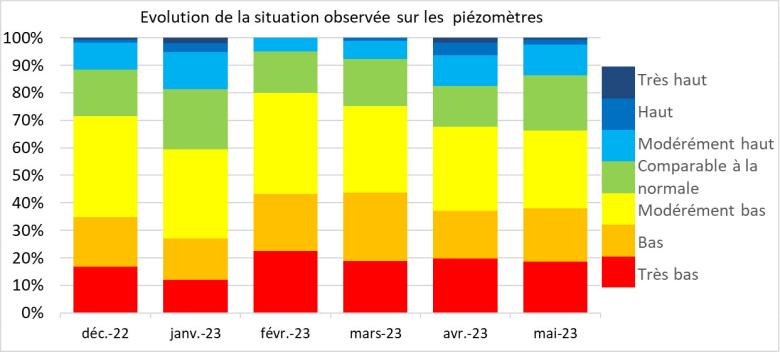






Map drawn up by BRGM on 10 June 2023, based on data from the ADES database, acquired up to 31 May 2023. Data source: ADES database / Map background © IGN, BD Carthage.
This map shows the global indicators reflecting the average fluctuations of the aquifers. They are based on point indicators collected at groundwater level monitoring points (by means of piezometers).
The "Aquifer levels" indicator compares the current month’s figures with those of the same months in the entire record, i.e. at least 15 years of data and sometimes up to as much as 100 years of data. It is divided into 7 classes, from the lowest level (in red) to the highest (in dark blue).
The grey areas correspond to areas without unconfined aquifers, i.e. with an impermeable or semi-permeable layer above the aquifer, and/or sectors with a very low density of measuring points. This last case primarily concerns mountainous areas with small, heterogeneous aquifers.
The "Evolution of levels" indicator reflects the variation of the water level of the past month compared to the two previous months (stable, increasing or decreasing).
These global indicators reflect general situations and trends and do not take into account possible local disparities.